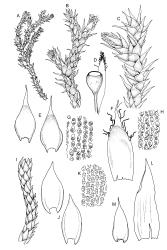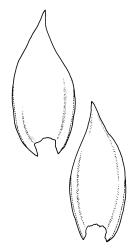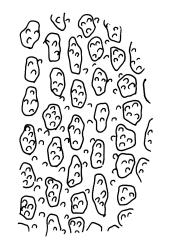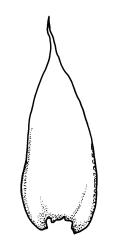- ≡ Hedwigia integrifolia P.Beauv., Prodr. Aethéogam. 60 (1805)
- = Braunia novae-seelandiae Beckett, Trans. & Proc. New Zealand Inst. 26: 275 (1894)
Hedwigidium imberbe sensu Dixon (1927)
Plants medium-sized, gold-green above, dark brown or nearly black in lower portions, stoloniferous, forming mats on dry rock. Protonema globular, irregular in shape, mainly composed of rounded cells (fide de Luna 1990). Stems creeping, branching irregularly, with numerous microphyllous stolons arising from lower portions, in cross-section with incrassate outer cells grading into parenchymatous medullary cells, lacking a central strand. Rhizoids numerous, scattered on stems and stolons, smooth, brown. Shoots julaceous when dry. Leaves crowded and appressed when dry, spreading when moist, broadly ovate or oblong-ovate, acute at apex, cordate-auriculate at base, ecostate, with two plicae running close to margins from the base nearly to the apex, entire, narrowly but strongly recurved on both sides nearly to apex, 1.4–1.8(–2.1) × 0.65–0.8 mm; upper laminal cells more or less rectangular, with strongly sinuose and incrassate walls, mostly (9–)12–15 × c. 6 µm, with a few to several low and inconspicuous papillae on each surface, becoming longer (to c. 30 µm) in lower third of leaf; cells at leaf apex scarcely differing from those of upper lamina; central cells at leaf base gold-brown, more or less linear, less incrassate and less sinuose, forming a large and conspicuous group; marginal cells at base subquadrate in c. 12–15 rows extending far up the margins and gradually merging with the upper laminal cells; alar cells gold-brown or orange, forming a large but ill-defined group, sometimes slightly inflated. Microphyllous leaves (of stolons) tapered to a slender and attenuate apex.
Autoicous. Perichaetia terminal on stems or on short branches, the inner leaves oblong and acute, entire, c. 3.0 mm. Perigonia bud-like, c. 0.8 mm, lateral on branches and stems (sometimes <4 mm below perichaetia), the bracts ovate-acute, concave, pigmented, surrounding numerous antheridia and few filiform paraphyses. Setae c. 1 mm, straight; capsules immersed, erect and symmetric, broadly oblong-cylindric, c. 1.5 × 1.0 mm, lacking a differentiated neck, longitudinally sulcate, gymnostomous, narrowed slightly to the transverse mouth; exothecial cells mostly isodiametric to oblong, in distinct alternating bands of thin- and thick-walled cells; stomata few, superficial, restricted to extreme capsule base; annulus nil; operculum umbonate, broadly rounded at apex, c. 0.35 mm long × 0.7 mm diam. Calyptra mitrate and elongate, c. 1.5 mm, 3–4-lobed. Spores round, 27–33 µm, finely papillose-verrucate.
Beckett 1894, pl. 26 (as Braunia novae-seelandiae); Scott & Stone 1976, pl. 68; de Luna 1995, figs 4–6, 21–26 (protonema only); Meagher & Fuhrer 2003, p. 61; Seppelt et al. 2013, pl. 10.
Hedwigidium integrifolium bears a superficial resemblance to Pseudoleskea imbricata; H. integrifolium is a plant of non-calcareous rocks, while P. imbricata is mostly found on limestone. Hedwigidium integrifolium is a more robust plant with ecostate leaves mostly >1.5 mm and rectangular, obscurely papillose upper laminal cells with incrassate and sinuose walls. The less robust P. imbricata, by contrast, has costate leaves <0.75 mm and short-rhomboid, rounded upper laminal cells that lack papillae (but are sometimes obscurely prorate). The two species differ in many other ways, including the nature of their basal leaf cells and their very different sporophytes.
Confusion can occur between Hedwigidium integrifolium and forms of Hedwigia ciliata with poorly developed leaf hair-points. The terminal leaf cells of Hedwigidium integrifolium differ little from the adjacent upper laminal cells, while those of Hedwigia ciliata, even if the hair-points are poorly developed, are invariably elongate-fusiform and multi-papillose. The entire perichaetial leaves of Hedwigidium also contrast with the ciliate margins in N.Z. material of Hedwigia.
Scott & Stone (1976, p. 355) noted that the leaves of Hedwigidium integrifolium do not "over-expand" upon wetting as do those of Hedwigia ciliata. They also correctly noted that the leaves of the stolons are prolonged into a multicellular hyaline hair-point.
NI: N Auckland (Taupō Bay, Penrose), S Auckland (near Ātiamuri), Gisborne (Mt Whanakao, East Cape), Wellington (Whakapapa Dam); SI: Nelson (Pyramid Rock), Canterbury (Lowry Peak Range, Lees Valley, Banks Peninsula, Mt Somers, Little Mt Peel, Sebastopol), Otago (Mt Watkin and vicinity, Lee Stream, The Neck, Mt Misery, head of Lake Wakatipu).
Anomalous. Tasmania*, Australia*, East Africa*, Europe*, northern South America*, West Indies*, Java*. Recorded from Mexico and Central America and western Europe (Crum 1994), South Africa (Magill & van Rooy 1998), and also from Sri Lanka.
On dry, non-calcareous rock (including schist, greywacke, and basalt); largely restricted to the drier parts of both main islands and best documented from Canterbury and Otago. The elevation range is poorly documented. On NI it occurs to at least 915 m (East Cape, Gisborne L.D.) and on SI from 200 m (Banks Peninsula) to at least 915 m (Little Mt Peel, Canterbury L.D.). Hedwigidium integrifolium is very often associated with Cladia aggregata and Hedwigia ciliata; other less frequent associates include Campylopus clavatus, C. introflexus, Racomitrium crispulum s.l., R. pruinosum, Rhacocarpus purpurascens, Frullania falciloba, and Usnea sp.
Material with "short, glistening, occasionally reddish, cuspidate points", described from type material of Braunia novae-seelandiae at Kew by Dixon (1927), has not been observed. Type material of this name in the Beckett herbarium (from which the Kew material was segregated) lacks red, cuspidate leaf points. I agree with Dixon (1927, p. 240) that B. novae-seelandiae is best considered a synonym of Hedwigidium integrifolium, provided the ample fruiting plants of Hedwigia ciliata in the type collection are excluded from the concept. Beckett recognised the heterogeneity of this collection and mentioned it in the protologue.









